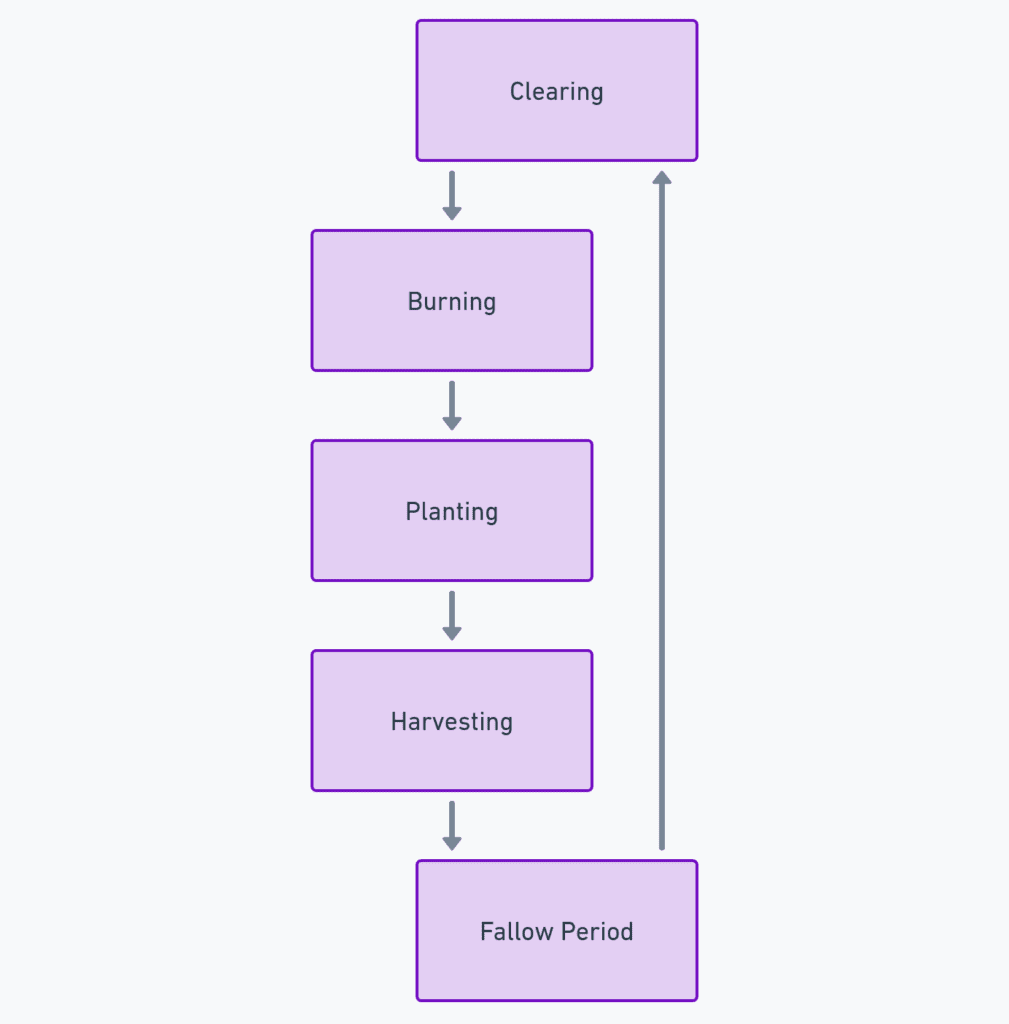December 6, 2025 9:29 pm
Introduction

Shifting cultivation, commonly known as Jhum cultivation in India, is an ancient agricultural practice widely used by indigenous communities, particularly in the Northeast and forested regions of Central India. This method of farming involves clearing a piece of forest land, cultivating crops on it for a few years, and then moving to a new area once soil fertility diminishes. Though often perceived as unsustainable, Jhum cultivation has been a sustainable farming system for centuries, tailored to the needs and environmental conditions of forest-dependent communities.
Process of Shifting Cultivation
The process of Jhum cultivation typically follows these steps:

- Clearing: Farmers select a patch of forest land, usually on a hillside, and clear it by cutting down vegetation. The cut vegetation is then left to dry under the sun.
- Burning: Once the vegetation is dry, it is burned to clear the land and enrich the soil with ash, which acts as a natural fertilizer, adding nutrients like potassium to the soil.
- Planting: After burning, seeds are directly sown into the soil without the need for plowing. Mixed cropping is often practiced, with farmers planting various types of crops, such as rice, maize, millet, beans, and tubers, to maximize productivity and resilience.
- Harvesting: The crops are tended to until they are ready for harvest. Once harvesting is completed, the plot is usually abandoned to allow natural vegetation to regenerate, which can take several years.
- Fallow Period: The cleared land is left fallow, allowing the forest to regenerate. During this period, the farmer moves to a new plot. The fallow period can range from a few years to over a decade, depending on the availability of land and local practices.
Regions Practicing Shifting Cultivation
Jhum cultivation is primarily practiced by tribal communities in Northeast India, including states like Assam, Nagaland, Mizoram, Manipur, Tripura, and Arunachal Pradesh. It is also found in Chhattisgarh, Jharkhand, and Odisha. Each region has its own name for the practice, like Podu in Odisha and Andhra Pradesh, Bewar in Madhya Pradesh, and Kumri in Western Ghats.
Benefits of Shifting Cultivation
- Soil Fertility Management: The burning process releases nutrients stored in plant matter back into the soil, making it fertile and suitable for agriculture without synthetic fertilizers.
- Biodiversity Conservation: Shifting cultivation promotes biodiversity as it involves mixed cropping and leaves land fallow, which encourages natural regeneration of native species.
- Low Input Costs: It requires minimal external inputs, as the process relies heavily on natural resources and manual labor, making it a cost-effective practice for subsistence farmers.
- Sustainable Land Use: When practiced with adequate fallow periods, shifting cultivation can be environmentally sustainable. It supports a cyclic renewal of forest vegetation, which helps maintain ecological balance.
- Cultural Significance: Shifting cultivation is deeply integrated into the cultural practices of indigenous communities, where it is more than a livelihood— it’s a way of life tied to social and spiritual traditions.
Challenges and Environmental Impact
- Deforestation and Soil Erosion: In cases where fallow periods are reduced due to land scarcity or population pressure, shifting cultivation can lead to deforestation and soil erosion, as the land does not have enough time to recover.
- Loss of Soil Nutrients: Over time, the repeated cycles of burning and cultivation can deplete soil nutrients, reducing the land’s fertility and productivity.
- Climate Change: The burning of vegetation releases carbon dioxide into the atmosphere, contributing to greenhouse gas emissions and climate change.
- Land Use Conflicts: As forests are often declared reserved or protected by government authorities, shifting cultivators face conflicts over land use, with their practices being seen as a threat to conservation efforts.
- Legal Restrictions: In some areas, shifting cultivation is illegal or highly regulated, as governments aim to prevent deforestation and promote settled agriculture, which can lead to marginalization of traditional communities.
Modern Perspectives and Government Policies
Many governments and environmental agencies view shifting cultivation as unsustainable, advocating for alternative methods like agroforestry or permanent agriculture. However, there has been a growing recognition of the cultural and ecological value of shifting cultivation.
In recent years, there have been efforts to integrate traditional practices with sustainable land management strategies. For example:
- Agroforestry initiatives: These allow farmers to grow trees alongside crops, maintaining tree cover while cultivating the land.
- Participatory Forest Management: Some regions have implemented community-based forest management programs that allow local communities to use the forest sustainably.
Conclusion
Shifting cultivation, or Jhum cultivation, remains a crucial part of the agricultural and cultural landscape in forested regions of India. While it faces environmental and legal challenges, the practice has sustained indigenous communities for generations and adapted to their unique ecosystems. A balanced approach that respects traditional knowledge while incorporating sustainable practices can help mitigate its environmental impact and preserve this culturally significant form of agriculture.
JPSC Notes: Access expertly curated notes covering essential topics for both JPSC Prelims and Mains exams.
14th JPSC PT Exam Comprehensive Test Series: Enhance your preparation with a structured test series designed to cover all aspects of the JPSC Preliminary Test syllabus, emphasizing Jharkhand-specific topics and current affairs.
JPSC Notification 2024: Stay informed about the latest updates, including exam dates, eligibility criteria, and vacancy details for the JPSC 2024 examination.
General Introduction to Jharkhand for JPSC Exam: Gain a comprehensive understanding of Jharkhand’s history, geography, economy, and culture, crucial for the JPSC exam.
official Website: https://www.jpsc.gov.in/






[…] Shifting Cultivation (Jhum Cultivation): A Traditional farming of Jharkhand […]